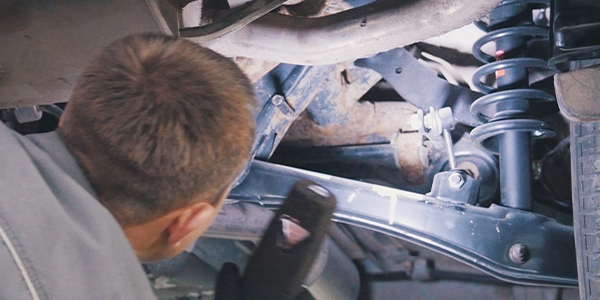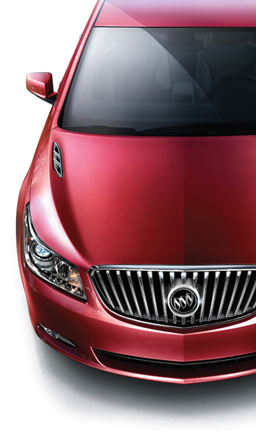 The second-generation Buick LaCrosse is built upon the mid-size Epsilon II platform. The Epsilon II platform will be the bread-and-butter of GM’s mid-size product strategy with revamped Malibu, Impala and Cadillac XTS models being launched soon. The chassis of the LaCrosse sets the bar high in terms of alignment service.
The second-generation Buick LaCrosse is built upon the mid-size Epsilon II platform. The Epsilon II platform will be the bread-and-butter of GM’s mid-size product strategy with revamped Malibu, Impala and Cadillac XTS models being launched soon. The chassis of the LaCrosse sets the bar high in terms of alignment service.
If you get a LaCrosse in your alignment bay, you could be dealing with several new technologies at once. Options and packages on the LaCrosse can be difficult to define by the badging on the trunk across all years. Visual confirmation may be needed. This article will help you prepare and perform a complete alignment on this vehicle.
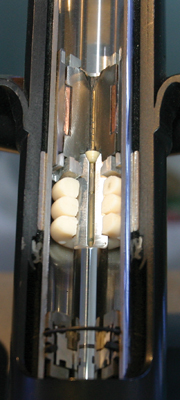 Ride Control
Ride Control
On some upper trim level cars, the suspension uses strut units with real-time dampening.
The system uses accelerometers on the front struts and on the body. The system also uses information from the electronic stability control system to change the rebound and compression of the struts in real time. Most of these are 2011 models and you will see a small black box mounted to the lower part of the strut.
The dampers are filled with magnetorheological fluid — a mixture of easily magnetized iron particles in a synthetic hydrocarbon oil. In each of the monotube dampers is a piston containing two electromagnetic coils and two small fluid passages through the piston. The electromagnets are able to create a variable magnetic field across the fluid passages. When the magnets are off, the fluid travels through the passages freely. However, when the magnets are turned on, the iron particles in the fluid create a fibrous structure through the passages in the same direction of the magnetic field.
The strength of the bonds between the magnetized iron particles 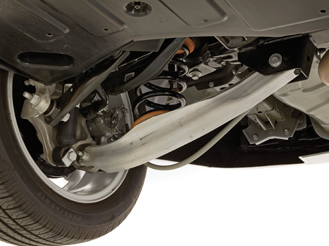 causes the viscosity of the fluid to increase resulting in a stiffer suspension. Altering the strength of the current results in an instantaneous change in force of the piston.
causes the viscosity of the fluid to increase resulting in a stiffer suspension. Altering the strength of the current results in an instantaneous change in force of the piston.
If the system is malfunctioning, it will set codes. Some of these codes will cause a light to be turned on and a message to be displayed in the driver information center. Some codes will not turn on a light, but will be stored in the control module.
If you get one of these vehicles in your shop and you have a scan tool that can access this module, scan the module for codes and look at the PIDs. You can learn a lot by looking at a good car.
Steering
The LaCrosse uses hydraulic power steering that is variable. The steering position sensor in the steering column is on the CAN bus.
The LaCrosse calibrates its own steering position sensor. But, if a component like a steering column or rack is replaced, you should look at the output of the sensor with a scan tool after the repair to confirm proper operation.
Rear Suspension
The rear suspension has built-in adjustments for toe and camber. Toe is adjusted with the cam bolt on the upper link. Camber is adjusted with the cam bolt in the lower link.
 Front Suspension
Front Suspension
The standard front suspension on most models is a conventional strut arrangement. Camber can be changed by elongating the lower bolt hole in the strut mount. It is possible to alter the camber by 1.75º± by using this method.
Front caster is not adjustable. If the caster exceeds specifications, check for damage to the bushings, control arm or crossmember. If the customer is complaining about popping or creaking noise while cornering, GM has directed dealers in a TSB to add a special lubricant and coating to where the steering rack mounts to the crossmember.
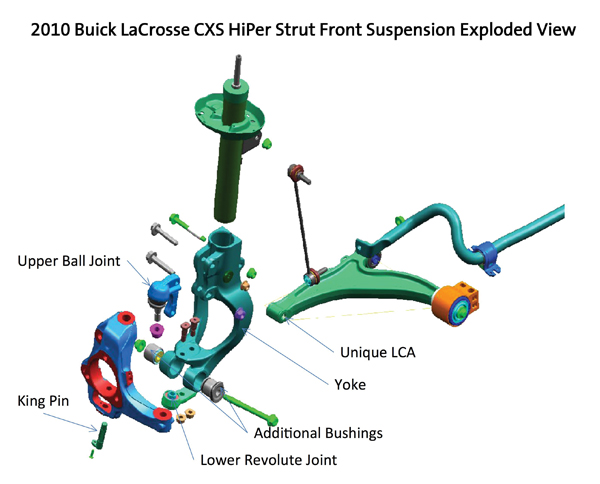 With the V6 in the Buick LaCrosse producing more than 280 hp, the engineers had to solve an age-old problem, torque steer. Torque steer is the lane changing behavior some vehicles have when the driver hits the gas. The effect becomes more evident when high torques are applied to the drive wheels either because of low transmission gearing, high engine torque, or some combination of the two.
With the V6 in the Buick LaCrosse producing more than 280 hp, the engineers had to solve an age-old problem, torque steer. Torque steer is the lane changing behavior some vehicles have when the driver hits the gas. The effect becomes more evident when high torques are applied to the drive wheels either because of low transmission gearing, high engine torque, or some combination of the two.
Some manufacturers have attempted to solve the problem with software in the electric power steering system or even cutting power when the throttle and steering angles indicate the driver is experiencing torque steer.
On the previous generation of LaCrosse with the V8, Buick installed a wider tire on the front than the rear.
For some 2011 models, Buick introduced the HiPer strut to correct this problem with the geometry that causes torque steer. The HiPer strut changes the SIA or “king-pin angle” so the angle to the tire’s centerline is less. They do this by placing two ball joints on the end of the strut.
The HiPer strut has a built-in camber adjustment by using a cam bolt in the upper bolt hole. The bolt is a torque-to-yield bolt with a special torque angle tightening procedure. Bolts should never be reused. The only difference in the alignment angles is the caster with 6.0º compared to 4.1 for the non-HiPer models.
TPMS
On the LaCrosse, GM has abandoned the key fob presses to start the relearn process. The relearn process can be started using the Driver Information Center. But, GM recommends using a scan tool to start the relearn procedure.
Each sensor has an internal low frequency coil. When the TPMS tool is used in activate mode, it produces a low frequency transmission that activates the sensor. The sensor responds to a low frequency activation by transmitting in learn mode. When the TPMS antenna receives a learn mode transmission while in TPMS learn mode, it will assign that sensor’s ID number to the location on the vehicle relative to the order in which it was learned.
TPMS Sensor Matching
1. Set the parking brake.
2. Turn the ignition switch to ON/RUN with the engine off.
3. Navigate on the DIC under the tire pressure monitoring menu. A scan tool that has acess to the BCM can also start the relearn cycle.
4. Starting with the left front tire, active the sensor by holding the TPMS tool aimed upward against the tire sidewall close to the wheel rim at the valve stem location. Press and release the activate button and wait for a horn chirp.
5. Once the horn chirp has sounded, the sensor information is learned and the turn signal in the next location to be learned will illuminate. On most models, the driver-side front turn signal also comes on to indicate that corner’s sensor is ready to be learned.
6. When a sensor ID has been learned, the module sends a serial data message to the BCM to sound a horn chirp. This verifies the sensor has transmitted its ID and has received and learned it. The module must learn the sensor IDs in the proper sequence to determine sensor’s location. The first learned ID is assigned to the left front location, the second to right front, the third to right rear and the fourth to left rear.
The learn mode will cancel if the ignition is cycled to OFF or if more than two minutes has elapsed for any sensor that has not been learned. If the learn mode is cancelled before the first sensor is learned, the original sensor IDs will be maintained. If the learn mode is canceled after the first sensor is learned, the following will occur:
• All stored sensor IDs will be invalidated in the RCDLR memory.
• The DIC will display dashes instead of tire pressures. If the learn mode is canceled after the first sensor is learned, the following will occur:
• All stored sensor IDs will be invalidated in the module memory.
• DTC C0775 will be set. These conditions will now require the learn procedure to be repeated for the system to function properly.












